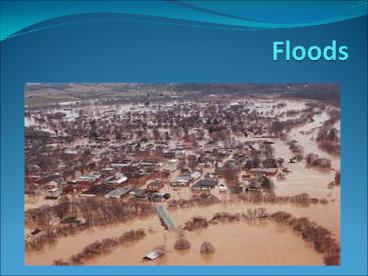Floods - PowerPoint PPT Presentation
1 / 15
Title:
Floods
Description:
Floods Most common natural disaster to strike the US A flood is typically associated with a defined body of water (river flood, ice jam, storm surge flooding etc.) – PowerPoint PPT presentation
Number of Views:554
Avg rating:3.0/5.0
Title: Floods
1
Floods
2
Floods
- Most common natural disaster to strike the US
- A flood is typically associated with a defined
body of water (river flood, ice jam, storm surge
flooding etc.) - An overflow or accumulation of a body of water
that submerges land - Floods occur when
- The soil cannot fully absorb the rainfall
- Bodies of water do not have the capacity to hold
the amount of rainfall
3
Flash floods
- According to the National Weather Service, a
flash flood is a life-threatening flood that
begins within 6 hours and often within 3 hours - Heavy rainfall
- Rapid run-off
4
Atmospheric Conditions
- Heavy rainfall
- moisture in the lower to mid levels of the
atmosphere - instability
- a source of lifting
5
Soil Conditions
- Dry soil leads to greater water absorption
leading to greater risk of flooding - Although ground saturation increases the runoff
risk, many flash floods occur when the ground is
not saturated - The texture of the soil also effects the
absorption levels
6
Where floods occur
- The type of land that is prone to flooding are
broad and flat usually situated on the banks of a
river or main waterway - River Deltas
- Mississippi, Nile, Amazon, Yangtze, etc.
- Canyons (gulley washers)
- Creeks, streams and rivers
- Levees breaching
7
Human influences
- Certain farming techniques, such as clear-cutting
land, doesnt allow water to return to the
atmosphere. - Construction of concrete and stone buildings-
these man made structures do not absorb water
well, which can lead to a sufficient amount of
water build up. (urbanization)
8
Energy of Moving Water
- Water possesses kinetic energy since it is moving
- It is falling through a gravitational field
(potential energy), and as it falls energy is
released and is used to move (kinetic energy) the
water - Energy is transferred to plants and the soil on
the banks of the creek - It is pushing on the soil and forcing it
downstream - Uprooting, some of the smaller trees and washing
them downstream - Only takes about 18-24 of moving water to lift
an SUV - Just six inches of fast-moving flood water can
sweep a person off his or her feet.
9
Ecological benefits
- Refill lakes and reservoirs
- Flooding waters transport silt/soil onto areas
(makes areas more fertile) - Floods was debris into waterways which can
provide habitats of organisms
10
Surviving a Flood
- Dont wait for bad weather. Make sure you have
everything you need in advance - Create a Disaster Pack
- Keep at home, or take along if you evacuate
- Include enough food and bottled water for three
days
11
Flood Terms
- Flood Watch Flooding is possible.
- Flash Flood Watch Flash flooding is possible. Be
prepared to move to higher ground. - Flood Warning Flooding is occurring or will
occur soon if advised to evacuate, do so
immediately. - Flash Flood Warning A flash flood is occurring
seek higher ground on foot immediately.
12
Surviving Floods Dos Donts
- Do leave if the local authorities recommend
evacuation - Do not walk through flowing water
- Do not drive through a flooded area (Turn
Around-Dont Drown) - Do not drink floodwater
- Stay away from power lines and electrical wires
- Look before you step
13
The Georgia Flood of 2009
- Atlanta metropolitan area
- Damage estimated cost to 500 million with the
potential for it to rise - 17 Georgia counties received Federal Disaster
Declarations - Hundreds of people were rescued by boat from
their homes - At least 10 people died
- Most in cars
14
(No Transcript)
15
The Economy
- Economic hardships due to
- Temporary decline in tourism (depending on
location) - Rebuilding costs
- Food shortage leading to price increase































